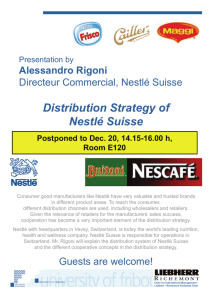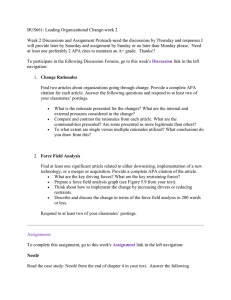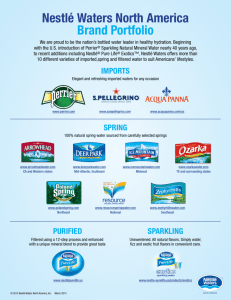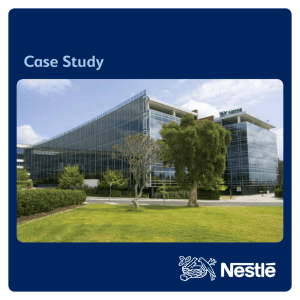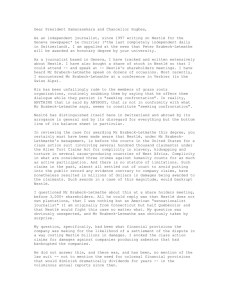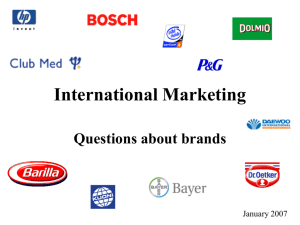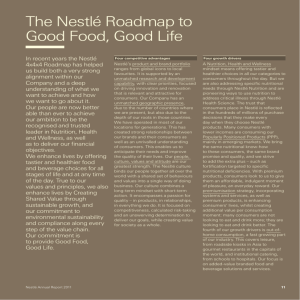Satisfying Our Customers
advertisement
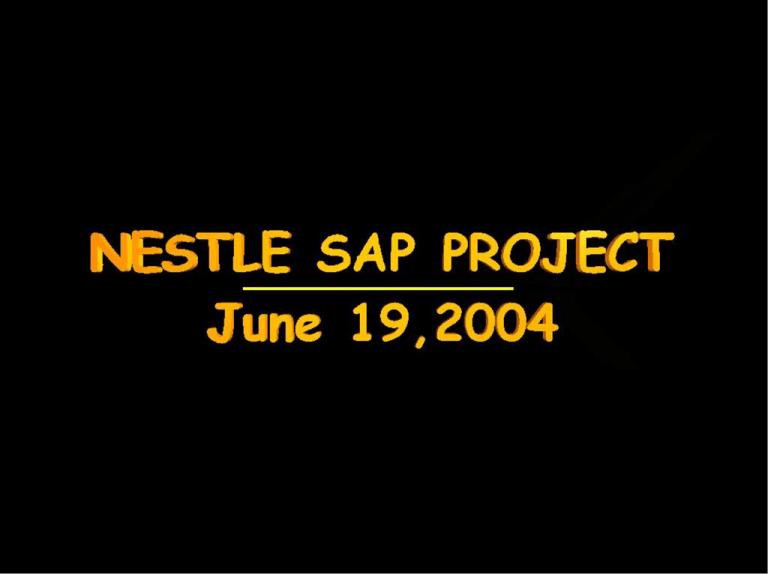
Nestlé USA's SAP project Ahmad Zelzle Marinela Vasile Rick Elston Samir Causevic June 19,2004 Agenda • • • • • • • • • • • • Nestlé “A global food powerhouse” Business need Business Process re-engineering Management Team Project Team SAP Nestlé's critical situation Resolution of the Project ERP Implementation generates savings for Nestlé Conclusion Lessons Learned Managing Change The Global Food Market- Introduction Food is a (3.5 trillion) USD 3,500,000,000,000 global industry 2% Nestlé Sales (2001) USD 51.1 billion Nestlé 98% Source: Nestlé SA Nestlé is the World’s leading food company 2000 food & beverage sales (alcoholic beverages excluded) ($ in millions) 50,000 45,000 40,000 Phillip Morris 35,000 30,000 10,000 5,000 General Mills Pillsbury 15,000 Unilever 20,000 Quaker Oats 25,000 0 Source: Nestlé SA NESTLÉ Trading RESULTS 2001 • Worldwide Sales: USD 51,112 million • Trading Profit: USD 5,766 million • Net Profit: USD 3,617 million • Factories: 468 in 85 Countries • Operating companies 200 • Employees: 224,541 • Real Internal Growth: 4.4 % GEOGRAPHIC SPREAD OF GLOBAL SALES Zone Europe 40.3% Zone Americas 39.0% Zone AOA 20.7% History of Nestlé 1867 1929 1938 1947 1960s 1970s 1980s 1990s 2000s In 1867, Henri Nestlé invented the world’s first infant food, saving a neighbor’s child who was unable to breastfeed. Background Nestlé USA “ Nestlé USA is named America's Most Admired Food Company for the sixth consecutive year “ -Fortune Magazine, March 2003 “Nestlé is indisputably a global powerhouse, with such well-known brands as Nestlé Crunch in candy, Nescafe in coffee, and Friskies in pet food” -Business Week, September 2002 In 1867, Henri Nestlé invented the world’s first infant food, saving a neighbor’s child who was unable to breastfeed. Nestlé USA • Part of the World’s Largest Food Company • Nestlé USA, which includes Nestlé Brands Company, Nestlé Prepared Foods Company, and Nestlé Purina PetCare Company, is a part of Nestlé S.A. in Vevey, Switzerland – the world’s largest food company. • $12 billion in sales in 2003 • 21,000 employees nationwide • 42 manufacturing facilities, 6distribution centers, and 58 sales offices Source: Nestlé SA Nestlé USA • What can go wrong with corporate systems implementation? "If you try to do it with a system first, you will have an installation, not an implementation" "And there is a big difference between installing software and implementing a solution" Jeri Dunn, vice president and CIO of Nestlé USA Source: CIO Magazine 2002 Business Need Vanilla is the root of all problems • In 1997, a team examining the various systems across the company found, among many other troubling redundancies, that Nestlé USA's brands were paying 29 different prices for vanilla—to the same vendor. Source: CIO Magazine 2002 Business Process Re-engineering • Spring 1997 Nestlé USA Chairman and CEO Joe Weller coined the term One Nestlé to reflect his goal of transforming the separate brands into one highly integrated company • In June, Dunn joined with executives in charge of finance, supply chain, distribution and purchasing to form a key stakeholder’s team “study what was right and wrong with the company” • 9 different general ledgers and 28 points of customer entry • Multiple purchasing systems • No clue how much volume Nestlé doing with a particular vendor because every factory set up their own vendor masters and purchased on their own Source: CIO Magazine 2002 Management Team • An implementation team of 50 top business executives • 10 senior IT people Did not include anyone from the management groups that would be directly affected by the new business processes !!! The team's goal was: To come up with a set of best practices that would become common work procedures for every Nestlé division. All the divisional functions—manufacturing, purchasing, accounting and sales— would have to give up their old approaches and accept the new panNestlé way Source: CIO Magazine 2002 Management Team Technical approaches : • Vanilla would be code 1234 in every division. – The SAP system would be customized around the uniform business processes. – In the case of the supply chain, the team decided not to use SAP because the ERP company's supply chain module • Advanced Planner and Optimizer or APO, was brandnew and therefore risky. • Instead, Nestlé turned to Manugistics—at that time an SAP partner. • Manugistics' supply chain module followed all the SAP standards and could easily be integrated. Source: CIO Magazine 2002 Project Team Project Manager: Jeri Dunn, CIO Nestlé USA IT Staff: 250 • IT Staff comprised of employees and consultants Special Advisors • Advisors to the project team from Nestlé – Tome James, Director Process Change – Jose Iglesias, Director of Information Services – Dick Ramage, VP Supply Chain Management SAP package A blueprint for major changes they thought could be made in 3 to 5 years The recommendation was an SAP solution Nestlé would implement five SAP modules • Purchasing • Financials • Sales • Distribution • Accounts payable and accounts receivable and the Manugistics' supply chain module Each would be organized across every Nestlé division Source: CIO Magazine 2002 SAP package con’t SAP project code-named BEST Business excellence through systems technology • Best will have gobbled up six years and more than $200 million • Development work began in July 1998 • The deadline for four of the modules was Y2K Speed created almost as many problems as it solved • The new systems would have to double as code fixes and be in place for the millennial change Source: CIO Magazine 2002 Nestlé's critical situation Beginning in 2000, the rollout had collapsed into chaos The implementation had been full of dead ends and costly mistakes • None of the groups that were going to be directly affected by the new processes and systems were represented on the key stakeholder team • Nobody knows how to use the new system, they did not even understand the new processes Source: CIO Magazine 2002 Nestlé's critical situation con’t • Nobody wanted to learn the new way of doing things • Morale tumbled • Turnover among the employees who forecast demand for Nestlé products reached 77 percent; the planners simply were not keen or unable to abandon their familiar spreadsheets for the complex models of Manugistics A technical problem: • In the rush to beat the Y2K deadline, the “Best project team” had overlooked the integration points between the modules. • All the purchasing departments now used common names and systems, and followed a common process, but their system was not integrated with the financial, planning or sales groups. Source: CIO Magazine 2002 Resolution of the Project Marc Richenderfer as project co-leader was removed Dunn gathered 19 Nestlé USA key stakeholders and business executives Looking through all constraints • The time constraints necessitated by Y2K had put too much pressure on the people in charge of executing the changes. • The project team had lost the big picture of how the various components would work together • The existing modules had to be integrated and the team still needed to roll out two more SAP modules—sales and distribution on the domestic side, and accounts receivable—as well as a new module for the supply chain Source: CIO Magazine 2002 Resolution of the Project • Dunn had rejected the SAP supply chain module before • Now improved and been named a Nestlé global standard • So she decided to replace all but a couple of parts of the Manugistics system with APO. Dunn estimates that last-minute change accounted for 5 percent of Best's $210 million total cost Major decision • Management Team decided to finish the SAP project • They would need to begin at the beginning, starting with the business requirements then reaching an end state • They also concluded they had to do a better job of making sure that they had support from key divisional heads and that all the employees knew exactly what changes were taking place, when, why and how. Source: CIO Magazine 2002 SAP Generates Savings for Nestlé The new SAP system has allowed Nestlé to reduce inventory and save on supply chain costs • By April 2001, the end-state design was complete, giving the project team a highly detailed road map to follow • Poor relationships between the divisions and the project team were solved by getting all stakeholders together for regular meetings • Started conducting regular surveys of how the employees affected by the new systems were dealing with the changes Source: CIO Magazine 2002 Conclusion With SAP • In place, common databases and business processes lead to more trustworthy demand forecasts for the various Nestlé products • Nestlé can forecast down to the distribution center level. That allows the company to reduce inventory and the redistribution of expenses • Supply chain improvements accounted for a major chunk of the $325 million Nestlé says it has saved from SAP Source: CIO Magazine 2002 Lessons Learned from Nestlé's ERP 1. Don't start a project with a deadline in mind. Figure out the project requirements, then determine how long it will take you to accomplish them 2. Update your budget projection at regular intervals. So many things happen during a long project that you will be lucky to stay on target during a particular year, let alone the life of the project. Frequently revisiting your numbers will help minimize troublesome surprises 3. ERP isn't about the software. It's easy to put a new system in place. The hard part is changing the business processes of the people who will use the system 4. Nobody likes process change, particularly when they don't know it's coming. Include in the planning the people whose processes you are changing. Keep the communication lines open while the project is in the works, and measure the level of acceptance before, during and after the rollout 5. Remember the integration points. It isn't enough to simply install new systems; you need to make sure that they can talk to each other Managing Change at Nestlé Benefits of the the ERP Implementation at Nestlé USA: • Allows Nestle USA to forecast demand with great precision giving the company a competitive advantage • Generated first year savings of $ 325 million • ERP paid for itself in less than a year after being rolled out across the organization • Stopped the high staff turnover (77% yearly) of the demand forecasting department Managing Change at Nestlé Nestlé SA to implement ERP tools across all its operating divisions • Nestlé has operations in 80 countries • Company sees ERP as a global advantage • ERP to standardize business processes across all operations • Challenge is to get stakeholders to buy in to benefits of ERP Thank you
